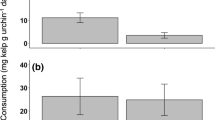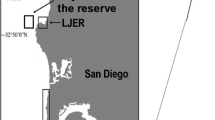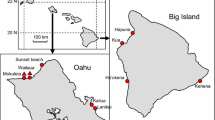Abstract
We documented spatial and temporal patterns of urchins (Strongylocentrotus droebachiensis) and periwinkles (Littorina littorea) in three habitats: a persistent Laminaria longicruris and L. digitata bed; an urchin dominated barrens, and the edge of the kelp bed that formed a boundary between the two. Urchins were rare in the kelp and, when present, always large and well hidden, a pattern we interpret as a response to crab and lobster predation. Urchins were abundant in the barrens, and, in the summer when predaceous fish were active during the day, foraged only at nigh. We observed the formation of a dense urchin feeding front along the kelp bed edge, and these urchins remained exposed and feeding even during the summer. Laboratory experiments demonstrated that aggregations are an effective defense against some predators, and that the presence of crabs increases the tendency of large urchins to aggregate. We hypothesize that healthy Laminaria spp. beds persist because kelp bed associated predators keep urchins at low densities and in hiding. A reduction in predation pressure permits urchin densities to increase to the point where they form aggregations, which provide better defense than hiding. These aggregations then graze destructively on Laminaria spp., forming barrens. These barrens seem to be a new, stable configuration of the system.
Similar content being viewed by others
Literature Cited
Breen, P. A. and K. H. Mann: Destructive grazing of kelp by sea urchins in Eastern Canada. J. Fish. Res. Bd Can. 33, 1278–1283 (1976a)
Breen, P. A. and K. H. Mann: Changing lobster abundance and the destruction of kelp beds by sea urchins. Mar. Biol. 34, 137–142 (1976b)
Chapman, A.R.O.: Stability of sea urchin dominated barren grounds following destructive grazing of kelp in St. Margaret's Bay, Eastern Canada. Mar. Biol. (In press)
Dayton, P. K.: Competition, disturbance, and community organization: The provision and subsequent utilization of space in a rocky intertidal community. Ecol. Monogr. 41, 351–389 (1971)
Drummond-Davis, N.: Population estimates of the rock crab, Cancer irroratus, in a kelp bed and some aspects of its feeding. 50 pp. M.S. Thesis, Dalhousie University (1978)
Evans, P. D. and K. H. Mann: Selection of prey by American lobster (Homarus americanus) when offered a choice between sea urchins and crabs. J. Fish. Res. Bd Can. 34, 2203–2207 (1977)
Garnick, E.: Behavioural ecology of Strongylocentrotus droebachiensis (Muller) (Echinodermata: Echinoidea). Oecologia (Berl.) 37, 77–84 (1978)
Hirtle, R. W. M. and K. H. Mann: Distance chemoreception and vision in the selection of prey by American lobster (Homarus americanus). J. Fish. Res. Bd Can. 35, 1006–1008 (1978)
Holling, C. S.: Resilience and stability of ecological systems. Ann. Rev. Ecol. Syst. 4, 1–23 (1973)
Johanssen, F.: Natural history of the cunner (Tauroglabrus adspersus Walbaum). Contrib. Can. Biol. N. S. 2, 423–468 (1925)
Jones, D. D.: The application of catastrophe theory to ecological systems. International Institute for Applied Systems Analysis (IIASA) Research Report. Schloss Laxenburg 2361 Laxenburg, Austria (1975)
Lang, C. and K. H. Mann: Changes in sea urchin populations after the destruction of kelp beds. Mar. Biol. 36, 321–326 (1976)
Levin, S. A. and R. T. Paine: Disturbance, patch formation, and community structure. Proc. Nat. Acad. Sci. USA 71, 2744–2747 (1974)
Loucks, O. L.: Evolution of diversity, efficiency, and community stability. Am. Zool. 10, 17–25 (1970)
Mann, K. H.: Ecological energetics of the seaweed zone in a marine bay on the Atlantic Coast of Canada. I. Zonation and biomass of seaweeds. Mar. Biol. 12, 1–10 (1972)
Mann, K. H.: Destruction of kelp-beds by sea urchins: A cyclical phenomenon or irreversible degradation? Helgoländer wiss. Meeresunters. 30, 455–467 (1977)
Mann, K. H. and P. A. Breen: The relation between lobster abundance, sea urchins and kelp beds. J. Fish. Res. Bd Can. 29, 603–609 (1972)
Mattison, J. E., J. D. Trent, A. L. Shanks, T. B. Akin and J. S. Pearse: Movement and feeding activity of red sea urchins (Strongylocentrotus franciscanus) adjacent to a kelp forest. Mar. Biol. 39, 25–30 (1977)
Miller, R. J. and K. H. Mann: Ecological energetics of the seaweed zone in a marine bay on the Atlantic Coast of Canada. III. Energy transformations by sea urchins. Mar. Biol. 18, 99–114 (1973)
Russo, A. R.: Dispersion and food differences between two populations of the sea urchin Strongylocentrotus franciscanus. J. Biogeogr. 6, 407–414 (1979)
Sokal, R. R. and F. J. Rohlf: Biometry. 776 pp. San Francisco: W. H. Freeman 1969
Vadas, R. L.: The ecology of Agarum and the kelp bed community. 282 pp. Ph. D. Thesis, University of Washington (1968)
Wharton, W. G.: The distribution of sea urchin dominated barren grounds along the south shore of Nova Scotia. In: Proceedings of the workshop on the effects of commercial algal/animal harvesting on sea urchin grazing dynamics. Ed. by J. Pringle, G. Sharp and J. Caddy. Canadian Technical Report of Fisheries and Aquatic Sciences 954 (1980)
Zeeman, E. C.: Catastrophe theory. Scientific American, April 1976, 65–83 (1976)
Author information
Authors and Affiliations
Additional information
Communicated by R. O. Fournier, Halifax
Rights and permissions
About this article
Cite this article
Bernstein, B.B., Williams, B.E. & Mann, K.H. The role of behavioral responses to predators in modifying urchins' (Strongylocentrotus droebachiensis) destructive grazing and seasonal foraging patterns. Mar. Biol. 63, 39–49 (1981). https://doi.org/10.1007/BF00394661
Accepted:
Issue Date:
DOI: https://doi.org/10.1007/BF00394661




